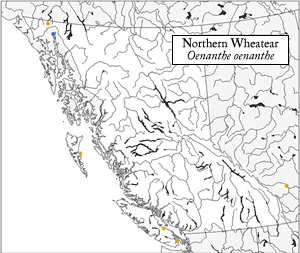Breeding male
This plumage is acquired in early spring (March-April) and is held into the late summer (August). The back and scapulars are pale grey, contrasting sharply with the bold white rump and uppertail coverts. The upperwings are uniformly blackish, although the secondaries and inner primaries may have narrow rufous-grey fringes and the lesser and median upperwing coverts may show some traces of pale grey. The tail has a distinctive pattern, with the black central feathers and tips of the outer feathers contrasting sharply with the white bases of the outer feathers to form an inverted “T” pattern. Underparts creamy-white (whitest on the central belly and vent) with a variable creamy-buff to yellow-buff wash on the breast. The crown and nape are pale grey and are separated from the black lores and ear coverts by a bold white supercilium that extends back from the extensively white forehead. The chin, throat, and malar area are creamy-white with a variable creamy-buff to yellow-buff wash. The iris is dark, the short, slender, pointed bill is blackish, and the legs and feet are blackish.
Breeding female
Similar to the breeding-plumaged male, but overall duller and browner, with richer and more extensively buffy chin, throat, and underparts (brightest, sometimes almost cinnamon-buff, on the sides of the neck). The lores and ear coverts are dusky-grey and do not form as bold of a dark “mask” as in the male. The wings are duller brownish-black, with more extensive pale fringes on the upperwing coverts.
Non-breeding adult
This plumage is acquired in late summer (August) and is held until early spring (March-April). The non-breeding plumage of both sexes resembles the breeding female, but the feathers of the upperparts are broadly tipped with olive or rusty-brown and the chin, throat, sides of the neck, and breast are richer cinnamon-buff, fading to paler buff on the belly and undertail coverts. The female averages duller and buffier than the male in non-breeding plumage.
Immature
This plumage is acquired in the late summer (August) of the first year and is held throughout the first winter. The upperparts are buffy-brown to buffy-grey, contrastring sharply with the white rump and uppertail coverts. The upperwings are brownish-black with extensive and broad buffy fringes on both the upperwing coverts as well as the flight feathers (primaries, secondaries, and tertials). The tail pattern is similar to that of the adults. The underparts are creamy-buff, palest and whitest on the belly and undertail coverts and richer cinnamon-buff on the breast. The crown and nape are buffy-brown to buffy-grey, the supercilium is buffy, the lores are dusky-brown, and the ear coverts are buffy-brown (slightly darher than the crown and nape); the chin, throat, and malar areas are buffy or cinnamon-buff. Bare part colouration is similar to that of the adults.
Measurements
Total Length: 14-14.5 cm
Mass: 23-24 g
Source: Kren and Zoerb (1997); Sibley (2000)
Oenanthe oenanthe (Linnaeus, 1758)
Northern Wheatear
Family: Muscicapidae
Species account author: Jamie Fenneman
Northern Wheatear
Family: Muscicapidae
Species account author: Jamie Fenneman
Species Information
Biology
|
Habitat
|
Distribution
|
Conservation
|
Taxonomy
|
Status Information
BC Ministry of Environment: BC Species and Ecosystems Explorer--the authoritative source for conservation information in British Columbia. |

